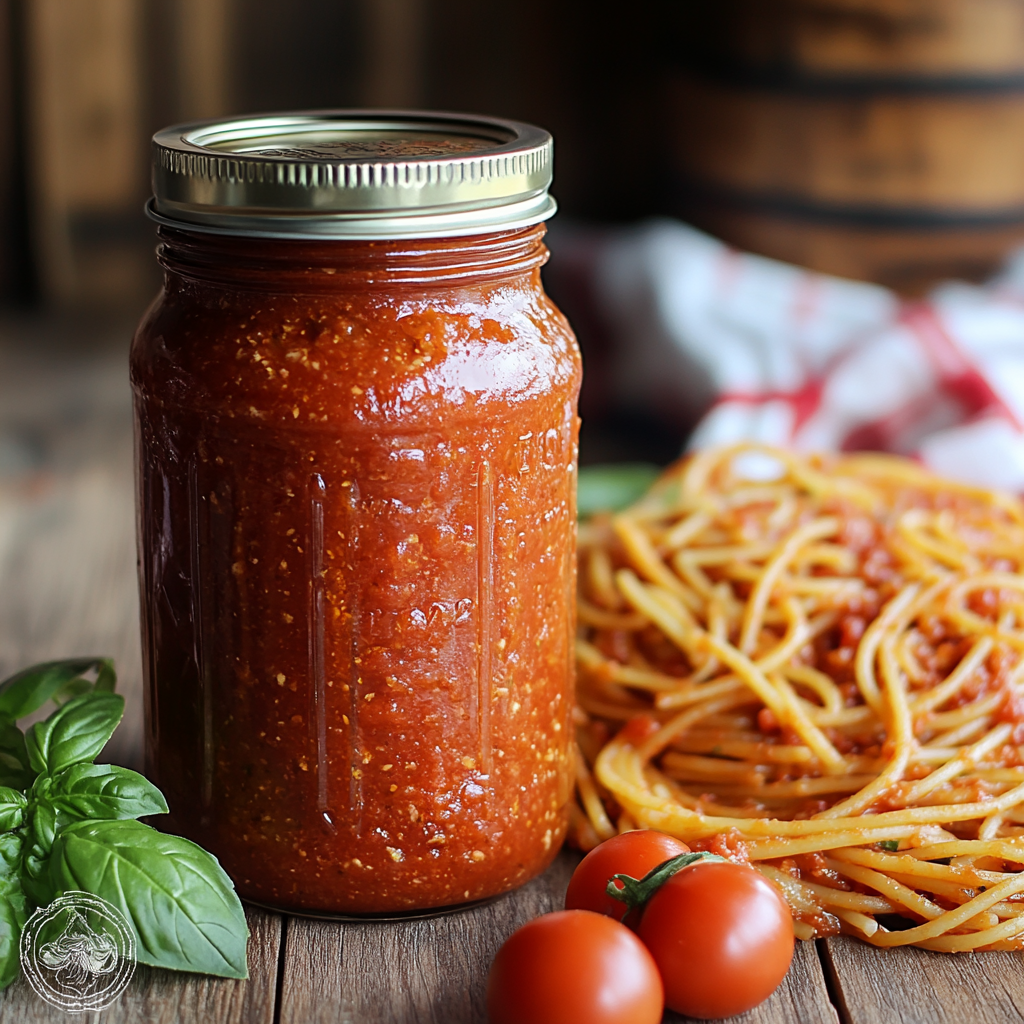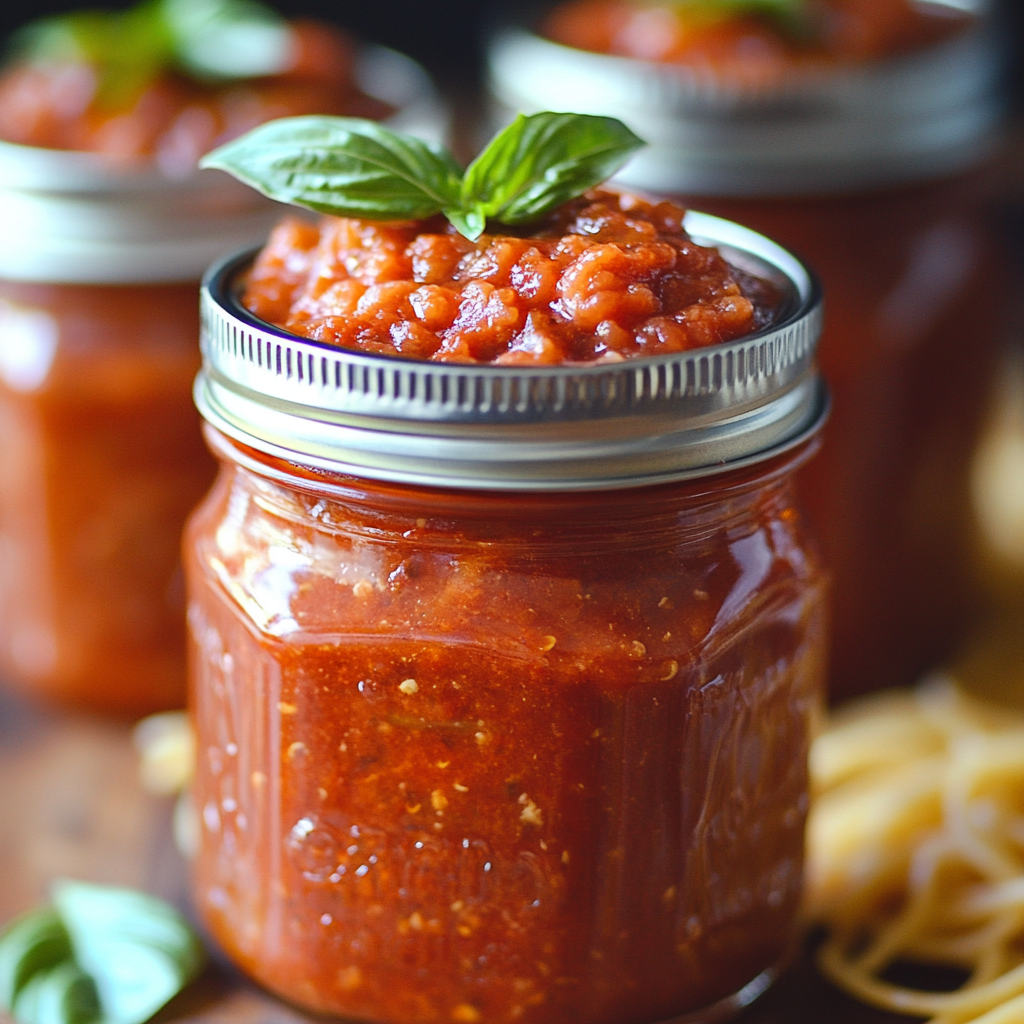
Imagine enjoying a warm slice of garlic bread with homemade sauce. That’s the magic of canning spaghetti sauce. It turns summer’s fresh tomatoes into a comfort food all year. This guide helps you make homemade spaghetti sauce for canning, just like a warm hug from your pantry.
Canning spaghetti sauce is more than just saving food. It’s about choosing the best tomatoes and avoiding additives. This guide covers safety, equipment, and ingredients. You’ll learn to make a pantry staple that beats store-bought and saves money.
Key Takeaways
- Master safe canning techniques to preserve fresh flavors year-round.
- Understand equipment basics like jars, lids, and pots needed for canning spaghetti sauce.
- Learn to select the best tomatoes and adjust acid levels for safety.
- Follow step-by-step instructions to avoid common mistakes.
- Enjoy cost-effective, healthier homemade spaghetti sauce for canning anytime.

Why Homemade Canned Spaghetti Sauce Is Worth the Effort
Making home canned spaghetti sauce is more than just convenient. It opens doors to better flavors, savings, and being kind to the planet. Here’s why it’s worth the effort in the long run.
Preserving the Garden’s Bounty
Homegrown tomatoes are at their best in summer, but their time is short. Canning captures their peak flavors. If you grow your own, jars of sauce keep the memory of your garden alive all year.
Even with store-bought tomatoes, canning turns them into a treasure for your pantry. It’s a way to enjoy the season’s best all year.
Cost-Effective and Healthier Alternative
Buying a jar of sauce can be expensive. But making your own from fresh tomatoes, herbs, and vinegar is much cheaper. It’s also healthier because you avoid additives like artificial colors and too much salt.
A 2023 USDA study showed homemade sauce has 40% less sodium on average. This makes it a better choice for your health.
- Save $10–15 per quart vs. premium brands
- No preservatives or added sugars
- Customizable to dietary needs (vegan, low-sodium, etc.)
Creating a Convenient Pantry Staple
Imagine having home canned spaghetti sauce ready for quick meals. It’s perfect for pasta, lasagna, or pizza toppings. Stored properly, jars last 12–18 months, so you don’t have to rush to the store.
Having jars of sauce means you have control over what you eat. It’s a way to enjoy better-tasting meals, save money, and live more sustainably. That’s the magic of canning spaghetti sauce at home.
Essential Equipment for Canning Spaghetti Sauce
Learning to canning spaghetti sauce requires the right tools. Before starting, make sure you have these key items. They ensure safety and consistent results every time.
- Jars and Lids: Use USDA-approved mason jars like Ball or Kerr. Wide-mouth jars are best for easy stirring.
- Canner: You can choose between a water bath canner for high-acid recipes or a pressure canner for lower-acid ones. See the comparison below.
- Jar Lifter: A silicone-coated tool like OXO’s Stay-Cool Jar Lifter helps avoid burns when handling hot jars.
- Bubble Remover: A plastic spatula removes air pockets from jars during recipe canning tomato sauce. This prevents spoilage.
- Headpace Measurer: A simple ruler checks the space between sauce and lids.
| Comparison | Water Bath Canner | Pressure Canner |
|---|---|---|
| Use Case | Acid-rich recipes (e.g., tomato-based sauces) | Low-acid or meat-based recipes |
| Cost | $30–$80 | $100–$200+ |
| Brand Options | Ball 21-Quart Aluminum | All-Clad 22-Quart Pressure Canner |
Optional upgrades include magnetic lid lifters and wide-mouth funnel kits. Always clean your equipment with hot, soapy water after each use. Store rubber gaskets in open containers to prevent mildew.
Selecting the Best Tomatoes for Your Homemade Spaghetti Sauce for Canning
Choosing the right tomatoes is key for a great homemade spaghetti sauce. Look for varieties made for sauce, as they have less moisture. This helps avoid a watery sauce.
Recommended Tomato Varieties
Choose San Marzano, Roma, or Amish Paste tomatoes. They have dense flesh and few seeds, perfect for thick sauces. San Marzano is a USDA favorite for its sweet and tangy taste.
For gardeners, heirloom varieties bring special flavors. But, they might need lemon juice to meet acidity levels.
Ripeness Indicators
“Fully ripe tomatoes ensure the correct acidity needed for safe canning, reducing the risk of botulism,” advises the USDA.

- Look for deep red skins with no green patches.
- Press gently—ripe tomatoes yield slightly but don’t feel mushy.
- Aroma should be earthy and sweet, not sour or fermented.
Fresh vs. Previously Frozen Tomatoes
Fresh tomatoes are best for texture, but frozen can do in a pinch. Thaw frozen tomatoes first and strain excess liquid. This avoids diluting the sauce.
Frozen tomatoes might darken during cooking but keep flavor if stored right. Use them within 6 months of freezing.
For big batches, use 5-6 pounds of tomatoes per quart of sauce. Always get them from trusted farms or your garden. This ensures they’re ripe before canning.
Ingredients That Make a Safe and Delicious Home Canned Spaghetti Sauce
Choosing the right ingredients is key to making a tasty and safe home canned spaghetti sauce. Each part must taste good and be safe to eat. Here’s how to pick the best ones.
Understanding Acid Requirements for Safe Canning
Tomatoes are naturally acidic, but their pH can change. The USDA says to add 2 tablespoons of lemon juice, ½ teaspoon citric acid, or vinegar per pint. This keeps home canned spaghetti sauce safe from botulism.
“Low-acid foods require pressure canning, but properly acidified tomato-based sauces can be safely processed in a water bath canner.” — USDA Complete Guide to Home Canning
Herbs and Spices That Work Best
Choose herbs that keep their flavor after canning:
| Herb/Spice | Best Form | Why It Works |
|---|---|---|
| Basil | Fresh | Retains aroma even after canning |
| Oregano | Dried | Concentrated flavor withstands heat |
| Garlic | Minced fresh | Softens but retains depth |
Avoid fresh parsley (loses color) or red pepper flakes (can burn during processing).
Ingredients to Avoid When Canning
- Dairy (milk/cream): Promotes bacterial growth
- Large quantities of oil: Creates air pockets that trap bacteria
- Thickening agents (flour/cornstarch): Added later when reheating
Stick to low-acid ingredients like onions and garlic. But avoid adding extra carrots or celery—these dilute acidity. Always check if can spaghetti sauce be canned in water bath safely by following tested recipes.
Preparing Your Tomatoes: From Washing to Cooking
Getting your tomatoes ready is crucial for a great recipe canning tomato sauce. First, rinse them under water to get rid of dirt. Don’t soak them to avoid making them too wet. Use a soft brush for any tough spots.
- Peel tomatoes using one of these methods:
| Method | Pros | Cons |
|---|---|---|
| Hot water blanch/ice bath | Effortless peel removal | Requires two pots |
| Roasting | Deepens flavor | Adds 20-30 minutes |
| Food mill technique | Skips peeling entirely | Thicker sauce texture |
After peeling, take out the seeds for a smoother canning spaghetti sauce. Seeds can make the sauce too watery. Cut tomatoes into quarters, keeping some whole for thicker bases.
- Quick-cook method: Simmer 20-30 minutes for fresh flavor
- Slow-simmer approach: 2-3 hours for concentrated taste
Check the sauce’s consistency by spooning it onto a cold plate. Adjust the seasoning before you can it. Always use a tested recipe for safety.
“Tomatoes must reach 212°F during processing to destroy bacteria,” advises USDA guidelines. Acidic ingredients like lemon juice must be added as per canning standards.
The Complete Process for Canning Spaghetti Sauce
Learning to canning spaghetti sauce is a detailed process. It’s important to follow each step carefully. This ensures your homemade sauce is both safe and delicious. Begin by setting up your workspace and tools correctly.
Preparing Your Canning Environment
Organize your area into three zones: prep, filling, and processing. Make sure your countertops are clear. Gather all necessary tools, like a wide-mouth funnel and jar lifters. Keep everything clean and free from distractions.
Sterilizing Jars and Lids
To keep jars germ-free, use these methods:
- Boil jars in a large pot for 10 minutes, or use a dishwasher’s sanitize cycle.
- Submerge lids in simmering (not boiling) water to soften sealing compounds.
- Keep jars in hot water until ready to fill to maintain heat.
Filling Jars Properly
For safe sealing, follow these steps:
- Leave ½ inch headspace at the top of jars after filling.
- Use a nonmetallic tool to remove air bubbles by sliding it along jar sides.
- Wipe rims with a clean cloth to remove sauce residue before applying lids.
Processing Times Based on Jar Size
Adjust processing times based on your elevation and jar size:
- Pint jars (12 oz): 35 minutes in a boiling-water canner at elevations under 1,000 ft.
- Quart jars (32 oz): 40 minutes, adding 5 minutes per 1,000 ft of elevation.
- Pressure canner: 11 lbs pressure at sea level; adjust per USDA guidelines for altitude.
Always test seals after cooling by pressing jar lids—fully sealed lids should not flex. Store in a cool, dark pantry for up to 12 months.
Can Spaghetti Sauce Be Canned in Water Bath? Understanding Processing Methods
Choosing the right canning method is key for safe home canned spaghetti sauce. First, learn how acidity levels affect your choices.
Water Bath Canning Safety Considerations
Water bath canning is safe only if your sauce’s pH is below 4.6. Since tomatoes naturally have a pH of 4.3-4.9, adding acid is crucial. The USDA recommends this to prevent botulism.
Always follow tested recipes carefully. Skipping acid increases the risk of spoilage.
- Add 1 tbsp lemon juice per pint or 2 tbsp per quart.
- Use glass jars rated for home canning, such as Ball or Kerr brands.
When Pressure Canning Is Necessary
If your sauce includes low-acid ingredients like mushrooms, carrots, or onions, you must use a pressure canner. Water bath canning at 212°F isn’t enough to kill botulism spores in these cases. Pressure canners, however, reach 240°F, making them safer.
Testing pH Levels for Safety
Check your sauce’s acidity with pH strips or a digital meter before canning. Aim for a pH of 4.6 or lower for water bath safety. Here’s how to test:
| Step | Action |
|---|---|
| 1 | Blend sauce thoroughly. |
| 2 | Drop a pH strip into the mixture; compare colors to the chart. |
| 3 | If pH exceeds 4.6, discard the batch or add more acid. |
Always put safety first. Proper processing keeps your home canned spaghetti sauce safe and of high quality.
Troubleshooting Common Issues When Canning Tomato Sauce
When you’re making recipe canning tomato sauce, you might run into some problems. But don’t worry, knowing how to solve them will keep your sauce safe and delicious. Here are fixes for four common issues:
- Unsealed Jars: If your lids don’t seal, your sauce might spoil. This can happen if the jar cools unevenly or if there’s debris on the rim. To check if it’s sealed, press the center of the lid. If it flexes, put the jar in the fridge and use it within a week. For better results, clean the rim well and process the jars in a steady water bath.
- Liquid Loss: It’s normal for some liquid to evaporate during processing. But it can make the sauce look different. If your jar is sealed, it’s still safe to use. Just stir the sauce well before you serve it.
- Darkened Edges: Sometimes, the top layer of your sauce can darken. But if the jar sealed right, it’s okay. To avoid this, add 1 tbsp of lemon juice per pint before you process it. Always check the pH level to make sure it’s below 4.6 for safety.
- Watery Consistency: Sometimes, your sauce might get watery. This is because the starches settle. You can add tomato paste to thicken it in the future. If your current jar is watery, refrigerate it and stir it well before using. If you see mold or a bad smell, throw the jar away.
Always trust your instincts. If a jar looks bulging, cloudy, or smells bad, don’t use it. For homemade spaghetti sauce for canning, a little texture change is okay. But keep trying and learning. Always follow USDA guidelines and check the jar seals carefully each time.
Storing and Using Your Home Canned Spaghetti Sauce
Proper storage of home canned spaghetti sauce keeps it safe and tasty. Whether you used a water bath or pressure canner, follow these steps. Check jars often and use older batches first.
Proper Storage Conditions
Store jars in a cool, dark pantry at 50–70°F. Label each jar with the date and ingredients. Avoid areas with temperature swings, like near ovens or windows. Store jars upright to keep seals tight.
Shelf Life Expectations
Home canned spaghetti sauce stays safe forever if sealed. But, the best flavor is within 12–18 months. Over time, tomatoes may darken and herbs fade, but it’s still safe. Use older jars first for the best taste.
Signs of Spoilage to Watch For
Discard any jar showing these warnings:
- Foam or discoloration under the lid
- Acrid or sour odors
- Lids that flex up/down when pressed
| Sign | Action |
|---|---|
| Visible mold | Discard immediately |
| Broken seal | Refrigerate and use within 3 days |
| Foul odor | Never taste—throw away |
Use your jars beyond pasta. Simmer into soups, mix into chili, or braise meats with the sauce. Add to casseroles or use as pizza base for versatile meals. Always check seals before use.
Conclusion: Enjoying the Fruits of Your Canning Labor Year-Round
Learning to can spaghetti sauce has filled your pantry with homemade goodness. Each jar saves money, promotes health, and brings joy. You’ve also ensured your food is safe by following key steps.
Next, try making pizza sauce or salsa using the same canning tomato sauce recipe. You can tweak herbs and spices, but remember to keep acidity levels safe. Keep notes on your experiments to improve your recipes over time.
Home canning connects you to a tradition of self-reliance. It lets you control what’s in your food. Every jar in your pantry is a promise of quality, ready to make your meals better all year. Share with family or try new flavors. Your canning skills open a world of convenience and creativity. Keep learning, perfecting, and enjoying the fruits of your labor.
FAQ
Can spaghetti sauce be canned using a water bath method?
Yes, you can can spaghetti sauce in a water bath. But, it needs added acid like lemon juice or vinegar. This ensures the pH level is safe for preservation.
What is the best recipe for homemade spaghetti sauce for canning?
A top recipe for canning spaghetti sauce includes ripe tomatoes, onions, and garlic. Add herbs like basil and oregano. Don’t forget lemon juice or citric acid for safety.
How do I know if my home canned spaghetti sauce is safe to eat?
Check if your sauce is safe by looking at the seals. Make sure there’s no leakage, cloudiness, or bad smells. Store it in a cool, dark place.
What ingredients should I avoid when canning spaghetti sauce?
Avoid using too much oil, dairy, and low-acid veggies when canning. They can be risky during the process.
How long can I store my home canned spaghetti sauce?
Home canned spaghetti sauce lasts 12-18 months. Keep it in a cool, dark, and dry spot for best flavor and quality.
What signs indicate that my canned spaghetti sauce may be spoiled?
Look out for mold, bad smells, discoloration, or loose lids. If you see these, throw the jar away.
What are the recommended tomato varieties for canning spaghetti sauce?
Use paste tomatoes like Roma, San Marzano, and Amish Paste. They have low moisture and rich flavor.
How do I prepare tomatoes for canning spaghetti sauce?
Start by washing the tomatoes. Then, peel them in hot water or a food mill. Remove seeds if you want. Chop them before cooking into sauce.
What tools do I need for canning spaghetti sauce?
You’ll need a large pot, jar lifters, funnels, bubble removers, and headspace tools. These help with a safe canning process.




